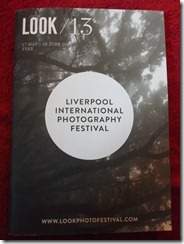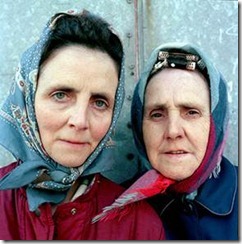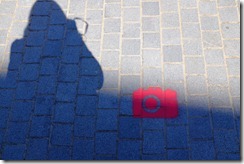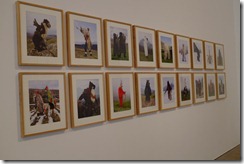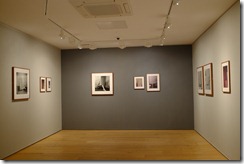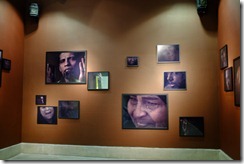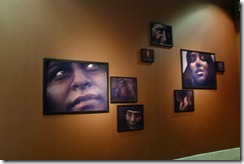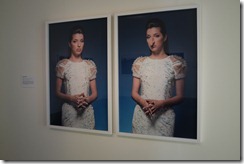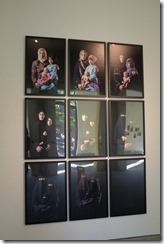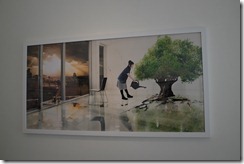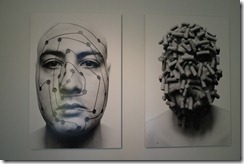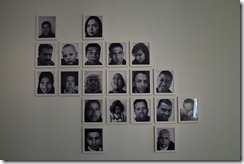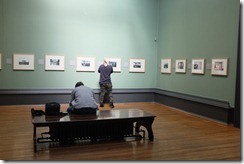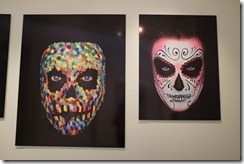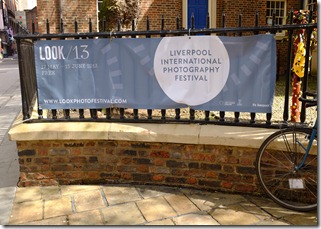I took advantage of the bank holiday weekend to visit some more of the galleries and exhibitions that are part of the Look 13 photography festival.
Wolstenholme Creative Space
‘Liverpool, Unfinished’ by Rob Bremner
I knew that I wanted to visit the Wolstenholme Creative Space to see ‘Liverpool, Unfinished’ by Rob Bremner as it has a very limited opening run. While it was further down Slater Street than I expected, the gallery space was signposted although when I arrived in the middle of day with bright sunshine, looking inside the dark space and empty room was a little concerning. In reality I had the preconception that I’d be looking at hung images, instead I was in a cool darkened space similar to being in a cellar and I had the whole place and slideshow (real slide negatives too) to myself, apart from the festival volunteer. With no light or anything to distract it was easy to focus on the images. While some whizzed past quite quickly and I would have liked to have studied them in more detail, my attention was purely on the content. Very much in the vein of Tom Wood, Bremner features a mix of different people and families in 1980’s Liverpool. A lot of the buildings and places seemed run down and tired, well before the huge regeneration projects, and while the fashions left a lot to be desired, I did wonder what had happened to these people, especially the young families and children. There was also a running though out which seemed to be very strong older women, looking like they had both physical strength and strength of character that you wouldn’t mess with. The images won’t set the world on fire, they are very much of a time and place that has been covered by other photographed but for a well composed snapshot into how Liverpool once was, it’s really worth seeing, and it’s a shame that Bremner has never finished this as I’d love to see the next generation of images that future exhibitions will show.
Further info and a sample of images at
I love this image, it’s from the festival programme and I wouldn’t upset these ladies.
I did try to get to the Museum of Liverpool but the Battle of the Atlantic festival was on and it was a struggle moving around the docks area. I then headed to the Open Eye gallery for their new exhibitions.
The Open Eye Gallery
There are two artists exhibiting inside the Open Eye Gallery, downstairs showing different series of work from Charles Fréger which is called ‘The World and the Wise’. Underneath this overall heading are five different bodies of work.
‘The Wild and the Wise’ by Charles Fréger
‘Wilder Mann, 2010’
The ‘Wilder Mann’ series involved Fréger visiting and observing 50 communities in 18 European countries, observing the different rites featuring traditional costumes and rituals that form part of the ‘wild man’. The images were all quite different, while the overall theme was evident, each country had a different take on the tradition and festival and it was only obvious when reading through the supplementary information that the history and different countries came out. I found that it wasn’t easy guess what some of these were and I found myself looking at the landscape more than the costumes trying to guess the background. As a series, I found it visually striking, I didn’t like the content of the images but I know that it’s just my personal choice and I can see that they are well composed and interesting. Some visitors while I was there just gave them a cursory glance, decided they didn’t like them and moved on. I’m not a fan of Fréger’s work but that’s my choice based on what I do and don’t find aesthetically pleasing and with my student head on it’s very interesting to look at and to notice the detail and wonder about the stories. I could see the running theme of identify through all of the images.
‘Penitente, 2004’
The back wall of the gallery was taken up with two large images of hooded figures, while it’s very hard to see any identify there, you can still see their eyes so feel a sense of personality in there even though you’ve nothing else to measure them on.
‘Legionnaires, 2000-2001’
This series consisted of 9 uniformed and 9 naked legionnaires, without the uniform, the identity is removed and you don’t get any indication of their background or who they are. For me I feel that their identity is within the uniform and they cannot tell their story without it.
‘Rikishi, 2002-2003’
This was the series on sumo wrestlers, my thoughts on this are very much in the same vein as ‘Legionnaires’. There were different costumes/outfits but I didn’t get a sense of coherency with these, I felt they were different portraits of people who do the same thing but that I didn’t feel it was anything more and that other series by Fréger told the story better than this one.
Other work in the exhibition included:-
‘Hereros, 2007’
What really stood out for me with this and linked the series was the splash of red that each subject whereas, some wear a lot, others are just a hint but this really catches the eye (and returns to an earlier post I made about the colour red and its occurrence in nature) and for me ties the whole set of images together.
‘2 Nelson, 2004’
This is a series on wrestlers and I found the composition more interesting that the content. The action all happens in the lower third of the frame and this is repeated through all of them, so they essentially all have a cream backdrop and most of the movement is on the blue mat. They have been composed so that there are heads and feet etc. outside of the frame. I feel that this was the photographer’s choice to show these where the subject is not square in the frame as it adds to the sense of action and movement and you can almost imagine them rolling out from one frame to the t next. Does it fit in with identity and who do I think I am? I’m not sure as part from showing two people at a pastime, there isn’t anything there that say identity to me. No more so than a photograph of myself in gym gear would give many clues away about myself.
‘Short School Haka, 2009’
I’ve seen the haka performed and know what it consists of, within this series, the images are linked with the themes of the dance and the school uniform. I felt that the bright primary colours of the uniforms gave these images their impact.
‘Drape’ by Eva Stenram
The second exhibition within the Open Eye gallery is ‘Drape’ by Eva Stenram, based on found images of pin up style photographs. The accompanying text with the exhibition states that ‘In the Drape series (2011-2012), the background- the drapes that give the show its title- and foreground are exchanged, Once the backdrop falls in front of the model (negating access to the subject and only showing glimpses of her objectified body), the viewer becomes fully aware of their voyeuristic desire and erotic impulses’
I felt from looking at these that any eroticism had certainly been removed, turning these images into more of a puzzle of to what the pose and outfits (if any) under the drapes would have been. In place we get what now seem to be strange poses and disembodied limbs which felt more humorous to me than anything else. I disagree somewhat with the statement that says now the images are covered, you become more aware of your feelings towards the subject. Having never seen the originals, I don’t think a viewer would come into this with any erotic impulses, and seeing the subjects covered and not having seen the original certainly won’t embody the view with voyeuristic desire as you don’t feel you are intruding or seeing something that you shouldn’t be.
The Bluecoat
‘I exist (in some way)’ Various Artists
‘I exist (in some way)’ features the work of photographers who explore, frame or reveal constructions of personal and collective identity in the contemporary Arab world. This description from the festival programme sums up the varied artists and work featured within this exhibition. I went through and looked at it all, and made notes about the pieces that really interested me. The first part I saw of this about a week before was by Laura El-Tantawy and while it was only a quick visit between events, I really enjoyed her work and found it stimulated me to think about the background of the people featured in the event. On the second visit I noticed more, there was actually a soundtrack playing which I think was of music and voices in Cairo- again I’d need to revisit, and I saw the background information on the theme of the images which was to present a view of pro-democracy subjects in the Tahir Square and surrounding streets during demonstrations. What I saw in the faces of grief but hope, was not from a loss or war, it was from passion to change their society. Knowing this doesn’t change the images for me, however it makes them easier to study as if I’m no longer intruding into a private moment.
I won’t summarise all of the work that I saw within this, just some key ones that I felt were worth a mention.
‘Through the looking glass’ by Lamya Gargash
Throughout the series, this really stands out as a different take on identity and how we see ourselves, and how we feel others see us. These feature two portraits of a subject, the first one is a standard portrait, and the subject is standing up against a coloured background. As portraits go, these are just normal people being photographed. Next to this then is a modified portrait where the subjects perceived flaw such as eye bags or a large chin have been exaggerated to monstrous proportions. When looking at the image of Lindsay, or Jimmy, I don’t notice the flaws that are exaggerated yet I can put myself in their place and think my flaws are hugely obvious. It’s a very sobering reminder that we’re not perfect and the only people looking for perfection are ourselves, when looking in a mirror we are our own harshest critics.
‘Mother, Daughter and Doll, 2010’ by Boushra Almutawakel
This piece of work is exploring gender through the overlapping viewpoints of Almutawakel, as a mother, a Muslim and a Yemeni woman, using different clothing from and differing levels of veils to cover up. I was really interested in the series of images and how the demeanour of Almutawakel and her daughter changes through each one. The first image is very colourful and positive, and with each change from the positioning of the veil/headscarf, the subjects seem to withdraw, they look more serious and by the end of the series when the veils also have an additional veil over the eyes and they are wearing gloves, it’s very hard to read a person from just the eyes. The final image is just of a black draped box and background, no sitter there at all, they are invisible. Reading a little more into this after I’d visited, the series focuses on the different levels of covering up that women can be expected to undertake, and while there are advantages and disadvantages of wearing a full hijab, the point is that the choice to be veiled should be up to the individual, not society or circumstances defining how other people should look and that comes across. If you look at the free choice in the first image, the artist is obviously more comfortable than later on when fully veiled and gloved. It’s certainly thought provoking as someone who has had the liberty to wear whatever I’ve wanted over as I’ve grown up.
Almutawakel also has some images in this exhibition entitled the ‘Fulla’ series, an Islamic version of the Barbie doll. This stood out as an interesting series for me, I loved Barbie and other dolls when I was younger and can see this as an interesting introduction to a different culture and westernised view. It’s certainly something that I’ll keep an eye and follow as I’d love to see where the character goes next.
‘French Muslim Women’ by Laura Boushnak
France has the continent’s largest Muslim population and this series features a wide range of women from differing ages who have converted to Islam and their lives as they bridge their new religion with traditional French society. The standout of these was that fact that Boushnak had captured the everyday normality that these women were taking part in, such as the outside exercise class and waiting for a train. These aren’t images about Muslim culture or being French, these are images that show whatever nationality of faith you are, we all do the same things.
My final highlight of this series was ‘Nation Estate’ by Larissa Sansour.
As I walked into the furthest gallery, my eyes were immediately drawn towards the Nation Estate poster that very much reminded me of ‘Metropolis’, the concept of everyone living in one huge skyscraper with different cities on each floor and it all being very futuristic really appealed to me. The large format images stood out and while they are very much composite images, they stimulated me into thinking what it would be like to be in a place so controlled that it was all in one building. Would I go stir crazy not being to get out and see something outside the skyscraper?
Other Images from the gallery
Sander/Weegee: Selections from the Side Photographic Collection
The upper gallery was split between a selection of images first from Weegee and then from Sander. I’d seen a couple of images from Weegee before in exhibitions but this was the first series I’d seen. Sander as a photographer was new to me, having only seen a couple of examples within books. The images from the series ‘Naked City’ were my favourite ones, really captivating and showing the ups and downs in people’s lives. The snapshots of the people and the city were fascinating, not glamorous and I felt quite gritty in both substance and the black and white film used (while this was the only affordable choice, it does add character in my eyes) The subject matter is not always easy to view, I found the building on fire more shocking by the advertisement that says ‘Simply add boiling water’ immediately linking the heat of the fire with the water being poured onto it. While looking at these images and seeing the tragedy in them, such as ‘Police helping wife of a murdered man’ isn’t always easy, they are one of the more interesting sets of street photography I’ve seen.
The Sander collection featured a number of portraits from working people such as a varnisher to circus artists. I had to guess about these people, some seem to be in a context that gives some clues whereas others are not. I think I would have liked to have seen some more images in the series, from what I did see, I liked a couple of them but the images from Weegee were more interesting to me.
The Walker Art Gallery
There are three exhibitions on at the Walker art gallery, I managed to see two while I was there and will go back for the portraits from the Keith Medley archive.
Every Man and Woman is a star featuring Martin Parr and Tom Wood
This features a mixture of images from both Parr and Wood. I’d seen a few of the Wood photographs the previous week at his talk so didn’t really focus on those too much as I was quite familiar with the all zones of peak and Chelsea reach nightclub images. I found it quite interesting to see Parr’s work in black and white compared to his usual saturated colour and to see his quite understated Irish scenes. I think we all have a preconception about how Parr’s images look and to see something a bit different was worth the visit.
Alive: In the face of death by Rankin
This was one of the exhibitions that I was most keen on seeing, I’d never seen anything exhibited by Rankin before, only magazine images and the changing gallery exhibition space in the Walker always puts on excellent exhibitions so I was looking forward to seeing a challenging body of work.
The exhibition welcomes you with a stunning image of Sandra Barber, which has been used for the cover publicity. She’s striking to look at, not because her hair is at a just growing back from shaved stage, but her strong black eye make-up as a mask and the feather collar really grab the eye. The accompanying text says that she’s showing her inner warrior and I have to agree, she looks strong, confident and inspiring.
Moving from this into an area with a series of ‘death masks’, based on the ‘day of the dead’ tradition, these are a series of images that come across as sugar coated and acceptable in a world where the skull is just another fashion symbol. These are striking to look at and throughout all of these images I see the highest quality, both in how technically perfect they are and the composition and colours.
Moving into the main gallery, there’s a mixture of themes, people who have survived a life threatening illness or event, life masks to celebrate the living, people who work with death and people who have a disability or illness which impacts them. Looking at the subject title, I expected this to be a little bit uncomfortable, but after spending some time in there and taking it all it, I get a feeling of strength, hope and positivity. It’s not negative at all and celebrates sheer strength of character. Some of the most eye-catching images are a series where the entire subject and background are coloured such as blue or white, while these were people who had been ill or had a near death experience, this didn’t come across, the use of the one colour all over them focuses the viewer, you don’t see their baggage. Reading their stories you feel their strength and their fight.
The life masks were interesting, having seen historical death masks previously in museums, the idea of a mask of a living person taken possibly when they are still youthful and vibrant is something to be celebrated more than capturing a death bed likeness and reminds us that life should be celebrated while we can. Some of the subjects have a disability or have an oxygen tube in the photograph, I notice these as I spent time studying each image, yet the notes I made were that even when you see that, you don’t really see it, you look through to the person and each image radiates strength.
Since coming back from this on Saturday I’ve been researching this more and looking at the stories behind the shoots and behind each of the people featured. On the ‘Alive’ blog http://alivexrankin.co.uk/blog/ it was announced that a week ago, one of the subjects Louise Page lost her fight with cancer. Her images were a set of feisty portraits in a Vivienne Westwood gown where she is smiling and then crying, even with smudged mascara and tear stains she looks like she’s fighting. That’s what I want to take from this exhibition, when faced with adversity, tragedy and pain all we can do is keep smiling and keep strong and powerful, and never stop fighting.

